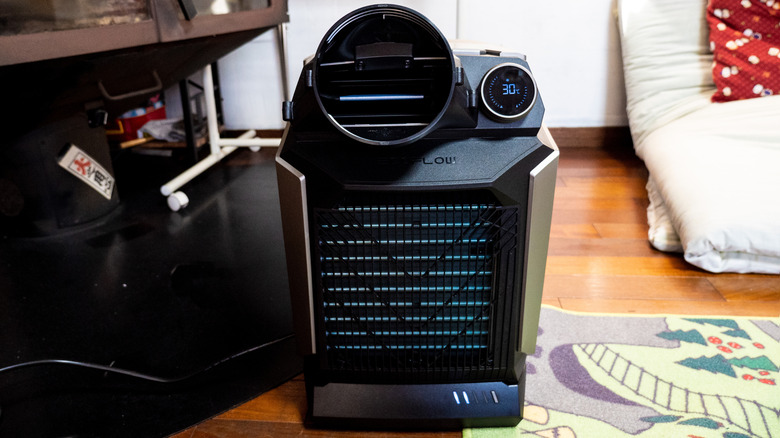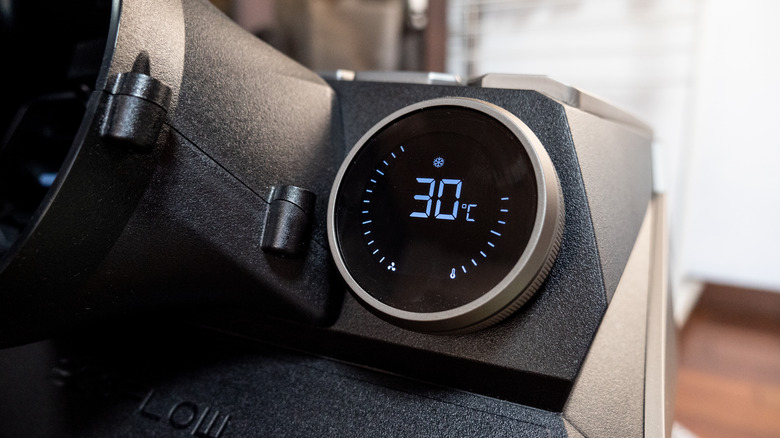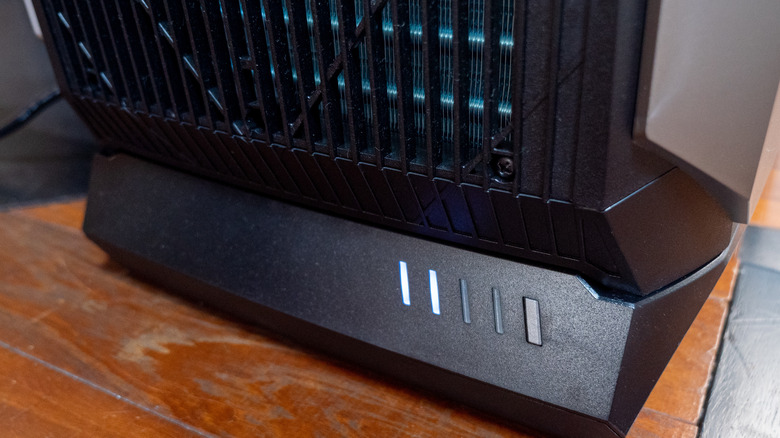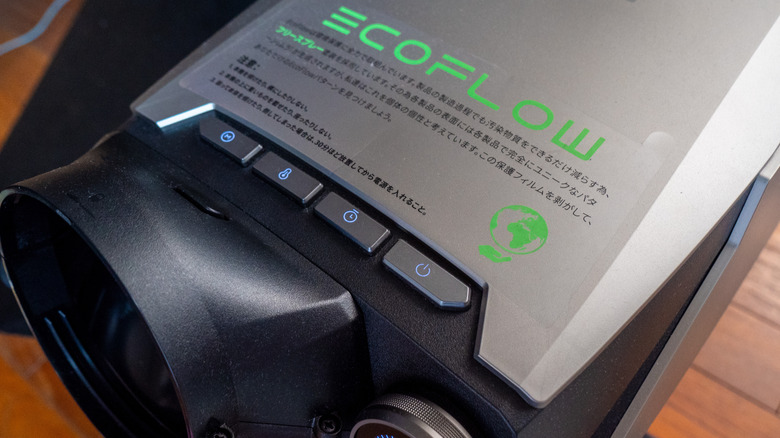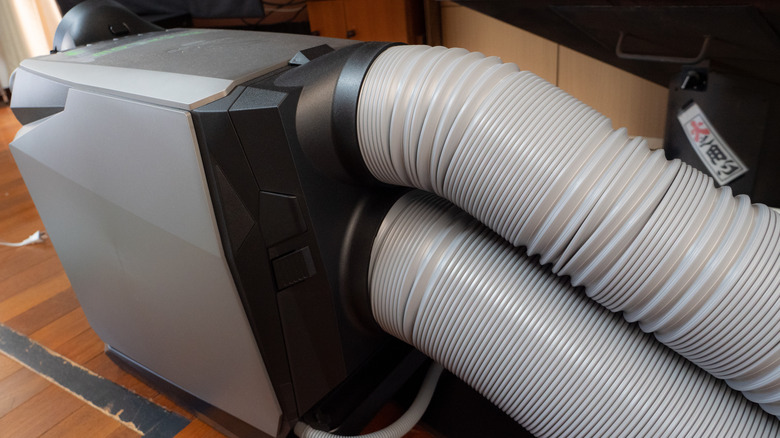EcoFlow Wave Portable Air Conditioner Review: Keeping Cool The Green Way
- Can be used anywhere, even without an AC outlet
- Quickly cools small spaces like rooms or tents
- Remote control and management via a smartphone app
- Smart No-Drain feature
- Compatible with EcoFlow DELTA power stations
- Can't be turned on or off remotely
- Practical but uninspiring design
- Can be quite loud in a smaller room
The sudden and extreme heat wave that gripped the U.S. and Europe in 2022 showed how many homes are not built to keep things cool. While electric fans might be enough for some, air conditioning units are still the preferred solution to that problem. They aren't always the best option, though, and certainly not the most sustainable. Standard A/Cs are large, heavy, and designed to be put in a single place, while those that advertise portability are really just glorified ice boxes with fans. The market for real portable air conditioners is still small, and there's plenty of room to innovate and stand out. EcoFlow is dipping its toes in that market, and — just like its myriad portable power generators — the EcoFlow Wave Portable A/C promises to keep you cool without heating up the planet. Naturally, we had to take it out — or, rather, indoors — for a spin to see how it measures up to the company's promises.
Unlike its portable power station cousins, the Wave isn't what you would call refined in terms of appearance. The model almost has an industrial bent to its design, putting functionality and practically ahead of style. It's not much to look at, as its aesthetic nears that of a gaming PC due to its odd edges and flat surfaces. With that said, the product gets the job done, and for EcoFlow's first try in this category, it's not too shabby.
Everything about the EcoFlow Wave – which has a regular price of $1,499 – screams efficiency, including the way parts are positioned. It has handles on the front and back for easier carrying, which is made possible by its 38.58-pound weight. The add-on battery does push that number to nearly 60 pounds, so you may want to detach it before moving the A/C. The cold-end air intake and output vents are both on the front, while the hot-end air intake and exhaust are at the back for more efficient cooling of an area, even without the use of duct hoses. There's a drainage outlet at the bottom backside of the A/C, but you might not need to use it, depending on where you are.
Cooling performance
The EcoFlow Wave is rated with a cooling power of 4,000 BTU, and it's advertised as able to cool a small area in just 8 minutes. Of course, that speed will depend largely on how wide the space is, and those figures were calculated for an area of 8 square meters. That's about the size of a four-person tent, so small bedrooms and small offices are a piece of cake for the Wave. EcoFlow says you can even use it outdoors in the open air, though its cooling efficacy will definitely take a hit.
If you do need to have the cold air directed to a specific location, you can easily attach the cold-end outlet shroud in the front. Like all air conditioners, the Wave works best if hot and cold air don't mix, which might be difficult if the hot air is also being pushed out in the same room. With that said, the cold air that the portable A/C does push out overpowers the hot air that it produces. If you really want maximum efficiency, though, you can attach the hot-end shroud to the back and have the two hoses directed to a different area outside of the room or tent. That's not necessary, but the option is there if you have a way to pump the hot air outside of the room, such as through a window or other opening.
Another typical consideration for A/Cs is the water condensation they produce. Most of the time, this requires that a hose be connected to drain the water, which can be inconvenient for portable air conditioning units. This is where the EcoFlow Wave's smart design comes in. Depending on where you live or how you're using it, you might not have to drain it at all. The Wave takes the water it produces and sprays that onto the internal condenser, making it evaporate on its own while cooling the component in the process. This works best in low-humidity environments where water buildup is minimal.
In high-humidity locations, you might need to drain the water manually by connecting a hose to the drainage outlet. The hose doesn't need to be connected all the time, though, and the A/C will automatically turn itself off if its water basin is full and there is no hose connected. This failsafe lets you use the Wave without cables or hoses for a period of time, allowing you to drain the water at your own convenience.
Power and battery
The EcoFlow Wave can be powered from a typical AC wall outlet, and while that might be the most convenient for home use, it's also the most unexciting and environmentally-unfriendly method. It also makes the portable A/C less portable unless you're sure you really won't be moving it around the house. The Wave, however, can run completely on battery power and never even touch an AC outlet thanks to EcoFlow's other products, offering a truly green cooling option — assuming you have the budget for it, of course.
The Wave comes with a 1,008Wh add-on battery pack that slides to the bottom of the unit. This lets the A/C run for around 3 hours in its default mode. That time can be extended to around 8 hours in Eco Mode, which switches between fan and cooling to squeeze out as much battery as it can for the longest period of time. You can even connect the Wave to the EcoFlow DELTA or other power stations from the company, allowing the use of the air conditioning unit without ever connecting it to an AC outlet.
Those batteries will eventually need to be charged, which can be done through the Wave so that you don't have to separate the two. While you can charge a connected battery while the A/C is running, it's safest to do so when it's powered off. Again, charging over an AC line might be the easiest and fastest, but there are other ways to charge it, like through a car charger. More importantly, you can also charge the Wave using EcoFlow's solar panels, the same panels that can be used to charge other power stations. With this method, you really don't need AC power at all and use green, sustainable power to keep yourself cool.
Controls
The EcoFlow Wave possesses a control system that's intuitive and simple, almost bordering on basic. The top of the A/C features four buttons that control most of the operations of the unit, from turning it on/off to changing modes. The physical buttons are clearly labeled, leaving no room for second-guessing their functions.
On the front of the Wave just beside the cold-end air output is a large dial with a circular LCD screen in the middle. The bright display has all of the information you need for keeping tabs on the A/C unit's status, at least when up close. That includes what mode it's in, its remaining battery level, and, of course, the temperature. Changing the temperature is a simple matter of turning the dial to the desired figure. Why the buttons have to be separated from the knob is anyone's guess, but it works, plain and simple.
Like almost all of EcoFlow's products, the Wave can be monitored and controlled remotely via a smartphone app. Fortunately, it's the same app you'll use for the company's power stations, so you won't have to install yet another one. The app connects to the A/C via Wi-Fi or Bluetooth, and almost all the information and functions you need are available at your fingertips. The one critical function that you can't access through the app is turning the unit on or off. You'll have to physically press the power button to turn it on, and automatically turning it off can only happen through a timer. That's not a deal-breaker, but it's an odd feature to leave out.
Final thoughts
Portable ways to keep on cool have been around for years. Some, like electric fans, have been on the market for decades even. Most portable cooling solutions, however, can only go the length of their power cord and use ice to create their cooling effect. Some portable air conditioners do still require a hose for the hot air or excess water, making them portable only in the sense that you can place them anywhere in the room with access to a window or drain. An honest-to-goodness portable A/C is still hard to find, especially one that really takes its portability seriously. In that aspect, the EcoFlow Wave has almost no competition, especially because of how eco-friendly it can be if you want to invest in green solutions.
The EcoFlow Wave definitely delivers on that fast cooling promise, especially with small to medium-sized enclosed spaces like rooms and tents. It can be used even without those hoses and shrouds, and you don't even have to worry about draining water in many instances. Its controls are easy to use, and the smartphone app makes all but one function available no matter where you are in the room. The Wave's killer feature, however, is the add-on battery that's so essential to using the product away from outlets. That it can work with EcoFlow's portable power stations is definitely a plus, but the ability to charge the battery using solar power really takes that freedom from the grid to the next level.
